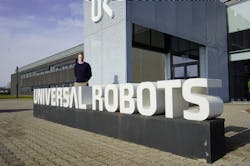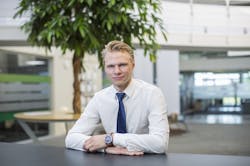Teradyne appointed Kim Povlsen as president of Universal Robots. Povlsen, a Danish native, brings global executive leadership from a high-tech and commercial perspective and will lead Universal Robots’ next stage of growth and innovation.
Universal Robots (UR) was founded in 2005 to make robot technology accessible to all by developing small, user-friendly, reasonably priced, flexible collaborative robots (cobots) that are safe to work side-by-side with people (Figure 1). The first cobot was launched in 2008.
The company, which is a part of Teradyne, is headquartered in Odense, Denmark, and has regional offices in the United States, Germany, France, Spain, Italy, the United Kingdom, Czech Republic, Poland, Hungary, Romania, Russia, Turkey, China, India, Singapore, Japan, South Korea, Taiwan and Mexico.
Teradyne’s Industrial Automation Group was formed in 2020 and includes Universal Robots, Mobile Industrial Robots (MiR) and AutoGuide.
Povlsen’s appointment reinforces Teradyne´s commitment to Universal Robots’ Danish origin and its role in further developing the local robotics community.
“Kim combines a fantastic track record as a dynamic executive with a background in and a tremendous passion for robotics,” says Greg Smith, president of Teradyne’s Industrial Automation Group and acting president of Universal Robots.. “With Kim on board, Universal Robots is poised to strengthen its leadership in the global market for collaborative robotics. With Kim’s leadership, we can accelerate the growth in new applications and market growth for cobots. Universal Robots was one of the original companies at the core of the Odense innovation hub for robotics, and our global customers recognize the innovation and quality of that Danish heritage. I’m thrilled to have a Danish executive who can build on our achievements and support the further development of our robotics hub and headquarters in Odense.”
Povlsen has held various executive business and technology leadership roles at Schneider Electric. Most recently, he served as vice president, strategy & technology. Povlsen lives in Aarhus, Denmark, and holds a master’s degree in computer science & embedded engineering from the University of Southern Denmark. The university’s graduates include many of the innovators and business leaders from the renowned Odense robotics community.
“I have been impressed with Universal Robots for some time,” says Povlsen. “To me, the company represents the pinnacle of innovation and potential, and I was thrilled to be approached for this unique leadership role. The company not only pioneered the category of collaborative robots, created an ecosystem of partner technology solutions and a vast global distribution network to serve customers in their varied industrial automation needs, but it also has the potential to fundamentally reshape automation across the global economy.”
What are three key things that a machine builder, system integrator or manufacturer should know about your company?
Kim Povlsen, president, Universal Robots: We are focused on taking the time, cost and risk out of automation projects. All of our development activities are organized around this theme, and we deliver results by attacking all phases in a project.
Our focus on ease of use, rapid deployment and flexibility has allowed us to bring all the benefits of automation to an historically under-served segment of the industry: small and medium enterprises (SMEs). UR’s growth in this segment, particularly in high-mix/low-volume businesses, has been phenomenal and we are just scratching the surface.
We have shipped more than 50,000 cobots into every industry and every application segment. Unlike the all-or-nothing approach of traditional automation, UR has been very successful by pursuing incremental automation—modest investments, quickly deployed, that deliver ROI in months, not years.
What new technologies are driving product development and why?
Kim Povlsen, president, Universal Robots: We are focused on building unique partnerships in the industry. In particular, our UR+ program enables third-party developers and programmers to create and market accessories, peripherals, modules and extensions to the core UR robot family. From seemingly simple components, such as a gripper, to integrated application kits that deliver near complete solutions, each UR+ partner brings specific expertise to the industry. Our job is to build the hardware and software architecture that enables those developments, while protecting the performance and reliability of the UR robot family.
How does the Industrial Internet of Things figure into business strategy?
Kim Povlsen, president, Universal Robots: The Industrial Internet of Things (IIoT) is all about establishing connections between devices, but it is also about creating connections between machines and humans. Done right, IIoT has the potential to transform and increase the efficiency of these interactions and bring humans and technology closer together. A connected product will enable Universal Robots to offer a much broader line of services that optimizes product uptime and rapid response and enables our partners to collaborate on the deployment, service and maintenance of cobots much more efficiently than today. We’re seeing a number of new UR+ certified software solutions launching now that allow manufacturers to cloud-connect their UR cobots to monitor performance, receive alerts and support in real time and much more.
How will machine automation and controls alter the way companies staff their operations in the future?
Kim Povlsen, president, Universal Robots: Automation in general, and collaborative robots specifically, are solving the biggest long-term challenge in factories today: the manufacturing labor crisis. The demographic shift as the Baby Boomer generation retires and the lack of interest from younger generations to work in dull, dirty and dangerous (DDD) jobs is taking a toll in all industries. Savvy companies are investing in cobots to take over DDD applications, which is freeing up the skilled workforce to move to higher value-added tasks and assignments. A skills gap remains, which will favor candidates with better technical knowledge and problem-solving skills. UR is working on these challenges with unique online training programs through the UR Academy, and our EDU initiative to bring collaborative technology to all levels of education.
How is the development of software solutions impacting requirements for hardware?
Kim Povlsen, president, Universal Robots: Advanced software for complex applications is always hungry for more computing power, and our cobots are no exception. While we continuously improve the performance of our robot family, we also make sure our hardware and software architecture support the seamless integration of additional computing power that our UR+ partners bring as part of their solutions.
As engineering and IT continue their convergence, which one is and/or will be leading the direction of future automation and technology?
Kim Povlsen, president, Universal Robots: This is not an either/or situation for automation, but one that demands cooperation between the two disciplines. Engineering is more aligned to manufacturing, and IT is more aligned to pure data, but any large project will cross these boundaries.
Looking into the future, how will technology change your organization or other organizations over the next five years?
Kim Povlsen, president, Universal Robots: In the past 12 months we have seen seismic shifts in how capital equipment is sold, and, while the world is ready to move back to normal, some of these changes will not revert. Look for further developments in how equipment is supported and serviced and for continued reductions in the development cycle for new products.
INFOGRAPHIC: Universal Robots illustrates the history of the ‘cobot’
Mike Bacidore is the editor in chief for Control Design magazine. He is an award-winning columnist, earning a Gold Regional Award and a Silver National Award from the American Society of Business Publication Editors. Email him at [email protected].
About the Author
Mike Bacidore
Editor in Chief
Mike Bacidore is chief editor of Control Design and has been an integral part of the Endeavor Business Media editorial team since 2007. Previously, he was editorial director at Hughes Communications and a portfolio manager of the human resources and labor law areas at Wolters Kluwer. Bacidore holds a BA from the University of Illinois and an MBA from Lake Forest Graduate School of Management. He is an award-winning columnist, earning multiple regional and national awards from the American Society of Business Publication Editors. He may be reached at [email protected]

Leaders relevant to this article:



